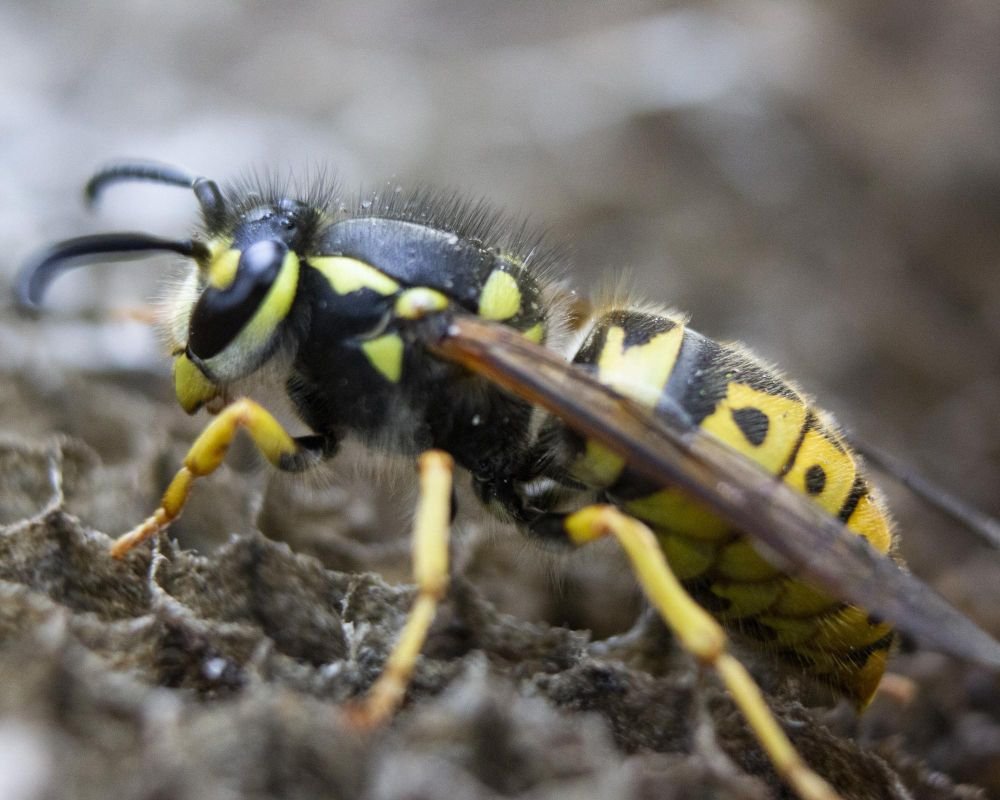Yellow jackets, while important for the ecosystem, can become dangerous pests when they nest in the ground near homes, playgrounds, or yards. Unlike bees, yellow jackets are aggressive and can sting multiple times, which makes them a serious nuisance—especially for those allergic to their venom. Ground nests are particularly tricky since they are often hidden until disturbed. This article discusses practical ways to kill yellow jackets, sharing methods that work and personal experiences for a comprehensive approach.
1. Understanding Ground Yellow Jackets
Yellow jackets often build underground nests in old rodent burrows, mulch piles, or grassy areas. These nests are harder to detect than aerial ones because the entrance is small, usually no larger than a quarter. You might notice them when you see many yellow jackets flying low to the ground. The most simple way to kill yellow jackets in the ground, pour boiling water mixed with dish soap into the nest entrance at night, or use insecticide dust for a more effective solution.
Signs of a Ground Nest:
- Swarms of yellow jackets entering and exiting a single hole
- Increased activity in one area of your yard
- A noticeable hum or buzzing sound near the ground
Identifying the nest early is key to taking action before the population grows too large.

2. Personal Case 1: The Late Summer Nest Under My Porch
Last August, I discovered yellow jackets swarming near the steps of my back porch. At first, I thought they were just foraging for food. However, after observing their behavior for a few days, I realized there was a nest under the porch foundation.
Steps I Took to Eliminate the Nest:
- Nighttime Attack: Since yellow jackets are less active at night, I waited until dark to approach the nest. Using a flashlight with red cellophane over it (yellow jackets don’t see red light), I found the nest entrance.
- Boiling Water: I boiled a large pot of water and poured it directly into the nest hole. The boiling water instantly killed many of the yellow jackets and flooded their underground tunnels.
- Dish Soap Solution: The next day, I added 1/4 cup of dish soap to a gallon of water and repeated the process. The soap suffocates the yellow jackets by breaking the surface tension of the water, making it harder for them to breathe.
Within two days, the nest was inactive, and there was no further yellow jacket activity in the area.
3. Personal Case 2: Yellow Jackets in the Garden Bed
One summer, I was pulling weeds in my garden bed when I accidentally disturbed a hidden nest. I was stung three times before I realized what happened. My immediate focus shifted to eliminating the nest for good.
Steps Taken to Kill the Yellow Jackets:
- Commercial Insecticide Dust: I purchased a yellow jacket dust insecticide (such as Delta Dust or Sevin Dust). At night, wearing long sleeves, pants, gloves, and a mask, I sprinkled the dust around and into the nest entrance using a duster tool.
- The dust works because yellow jackets carry it back into the nest on their bodies, poisoning the entire colony over 24-48 hours.
- Monitoring: Over the next two days, I monitored the nest from a distance. Activity drastically decreased, and by the third day, the nest was silent.
Why This Worked: Insecticide dust is long-lasting and doesn’t evaporate like sprays. It’s one of the most effective methods for ground nests.
4. Safe and Natural Alternatives
If you prefer a chemical-free approach, several natural solutions can also be effective. Here are a few:
A. Boiling Water and Soap
As mentioned earlier, pouring boiling water mixed with soap into the nest is a simple and eco-friendly solution. However, it may take two or three applications to fully kill the colony.
B. Diatomaceous Earth (DE)
Diatomaceous earth is a natural powder that damages the yellow jackets’ exoskeletons, causing them to dehydrate and die. Sprinkle food-grade DE generously around the nest entrance at night.
C. Vacuuming
Some people have successfully vacuumed yellow jackets using a shop vac:
- Place the vacuum hose close to the nest entrance at night.
- Run the vacuum for 30-60 minutes to suck up yellow jackets as they leave or return.
- Seal the vacuum bag and dispose of it carefully.
D. Essential Oils
Yellow jackets dislike peppermint oil. Mixing peppermint oil with water and spraying it around the nest entrance can repel them, but this method is less effective for killing the colony.
5. Safety Tips When Dealing with Yellow Jackets
When attempting to kill yellow jackets, your safety is a top priority. Follow these tips:
- Work at Night: Yellow jackets are dormant at night, reducing the risk of stings.
- Wear Protective Clothing: Cover your body with long sleeves, pants, gloves, and a face mask or beekeeper hat.
- Keep Your Distance: Never stand directly in front of the nest entrance.
- Have an Escape Plan: Be ready to move quickly in case the yellow jackets become agitated.
- Avoid Allergic Reactions: If you have a history of allergies, keep an epinephrine auto-injector (EpiPen) on hand and consider calling a professional exterminator.
6. When to Call a Professional
If the nest is large, located in a difficult spot, or if you are allergic to stings, it’s best to contact a pest control professional. Professionals have specialized tools, protective equipment, and knowledge to eliminate nests quickly and safely.
Conclusion: The Best Strategy to Kill Ground Yellow Jackets
Ground-nesting yellow jackets are a serious problem, but with persistence and the right methods, you can safely eliminate them. Whether you choose boiling water, insecticide dust, or a natural solution like diatomaceous earth, acting carefully at night will give you the upper hand.
From personal experience, boiling water with soap and insecticide dust are the two most effective methods. However, for large or hard-to-reach nests, don’t hesitate to call a professional exterminator. Staying proactive and cautious will help you reclaim your yard without putting yourself in harm’s way.
Remember: Yellow jackets are aggressive, so always prioritize safety when attempting to remove a nest. A careful approach will ensure you stay sting-free while solving the problem.



